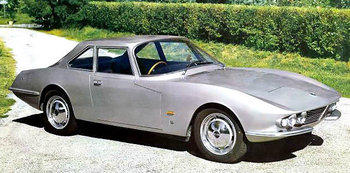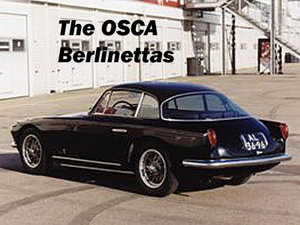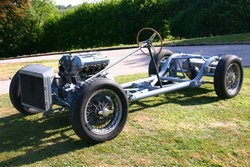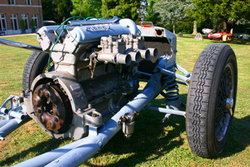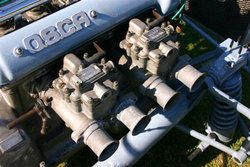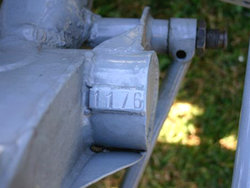OSCA
Officine Specializate Costruzione Automobili
After the death of Alfieri Maserati in 1932 the famous Bolognese car company was run by 49-year-old Bindo, 38-year-old Ettore and 34-year-old Ernesto. They were very successful but the arrival of the Mercedes-Benz and Auto Union Grand Prix teams meant that the success became increasingly difficult to achieve and that led to financial trouble. In 1937 the brothers agreed a deal with the Orsi Family, which ran a steel and machine tool empire headquartered in Modena, for them to take over the company. The brothers were retained as engineers on 10 year contracts. This arrangement worked successfully in the late 1930s but during the war the Orsis decided to move the factory to Modena and Alberto Massimino was brought in as chief engineer. When the war ended the Maserati Brothers departed and set up OSCA in San Lazzaro di Savena, in the suburbs of Bologna. Initially the brothers built small sportscars but in 1950 some of these were converted for Formula 2. In 1951 they built a new 4.5-liter V12 engine which was raced in old Maserati chassis by Prince Bira. The car won its first race at Goodwood in March that year, against low-key opposition but achieved little thereafter. At the Italian GP in September OSCA entered two works cars for Franco Rol but the car was a long way off the pace of the Alfa Romeos and Ferraris.
The car reappeared at the Valentino GP in Turin as the start of 1952 in the hands of Rol but it was off the pace again and with the adoption of Formula 2 regulations for the World Championship the Maserati Brothers ran one of its old F2 cars for Frenchman Elie Bayol and designed a new 2-liter straight six engine. This appeared in August and Bayol showed it had promise with sixth place at Modena in September. In 1953 he was joined by another OSCA customer Louis Chiron who finished second at Syracuse. The pair then finished fourth and sixth at Pau. In July Bayol won the Circuit du Lac at Aix-les-Bains beating the Gordini team. The change in the regulations for the World Championship in 1954 rendered the cars obsolete and it was not until a new 1.5-liter F2 began in 1957 that OSCA reappeared in single-seater racing with a new four cylinder engine. The company enjoyed some success in 1960 with victory in the Italian Formula Junior series but in 1962 the aging Maserati brothers sold the company the MV Agusta motorcycle company.
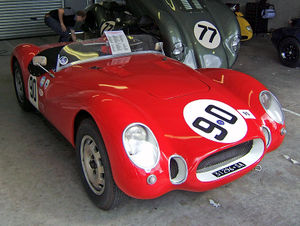
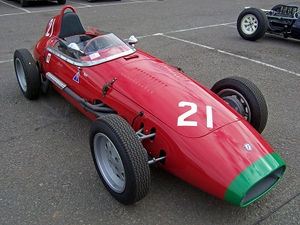
From 1951 to 1962, automobiles or engines made by O.S.C.A. also were entered in some Formula One and Formula Two events although they mainly built small sports cars of which some were designed by Pietro Frua. In the World Sportscar Championship OSCA vehicles ranked 10 (1953), 4 (1954), 6 (1957), 5 (1958) and 4 (1961).
The Formula Junior (FJ) used a Fiat engine of 1089ccm, saw wins by Colin Davis (driver), Stanguellini and Taraschi (1959).
In 1963 the brothers sold the company to Count Domenico Augusta, owner of MV Agusta, They did design work for Augusta until 1966. One of their final designs was a desmodromic four cylinder engine. It ended operations in 1967.
The OSCA Berlinettas
We've long been interested in the OSCA MT4 Berlinettas--a particularly virulent form of OSCAitis, as there were so few built. Several years ago Christophe Pund contacted us and said he had found there remains of 1176. It is being restored but no photos of the original car exist. He hopes someone might be able to help. In addition to Mr. Pund's story and photos, we've also provided the details of all the OSCA coupes in our article below.
OSCA, as it was nothing but another name for the Maserati brothers, did not readily agree to built street cars. The brothers four built race cars. Period.
Of course there were exceptions, rare ones, and most of the exceptions were built in the guise of coupes, street coupes and GTs, of which the last of the line OSCA 1600GT was the most famous and certainly the most numerous, with some 56 examples built.
But of the heralded MT4 line, there were very few cars built to coupe specs; the vast majority of the 76 odd MT4s were built as spiders. In fact only five MT4s were ever assigned by the factory to receive berlinetta bodies. The below information was compiled from the book “OSCA, La Rivincita dei Maserati“ by Orsini and Zagari.
Chassis 1113 This was purchased by Liugi Piotti of Milan in 1951. The chassis was sent to Frua, who created a tight, attractive berlinetta body for the car. The engine was originally number 1304 and was a 2AD 1350cc unit. A photo of the car appears on page 58 of the Orsini/Zagari OSCA book.
Chassis 1120 In 1952 Mario Damonte of Turin purchased this Vignale/Michelotti bodied coupe, with dramatic scalloped sides. The team of Damonte and “Helde” entered the street coupe in the 1952 LeMans 24 Hour and won first in class. Photo page 54 of “OSCA”.
Chassis 1136 Looking very much like a Ferrari, this Vignale coupe was built for Francia da Armangaud in 1953. Nothing further is known about the car or its history. See page 292, “OSCA”.
Chassis 1153 This is the now famous Vignale coupe recently sold at an auction, and perhaps the most beautiful of all OSCA coupes. Built by the factory, it was the 1955 Turin show car. It resided with collector Walter Grell for most of its life and is still totally original. Photo above.
Chassis 1176 The subject of this story, and by far the most mysterious of the OSCA coupes. While Morelli constructed many of the traditional OSCA spider bodies, they made a coupe for OSCA racer Jim Simpson. It was destroyed shortly after delivery and we have no pictures of the original body. Below are photos of 1176 as it exists today.
Of course there were other OSCA coupes, as in many cases, an early ’siluro’ (cycle fendered) bodied OSCA was later rebodied as a road going coupe. Here are three listed by Orsini and Zagari: Chassis 1105 Siluro bodied car, built in 1949. And after an accident in 1952 was rebodied as a Vignale coupe. In 1955-6 it was again changed into a spider. Photo page 185, OSCA.
Chassis 1108 A siluro for race driver Luigi Villoresi in 1949, he had it changed to a coupe by Vignale in 1951. In this form it looks remarkably like a small Vignale Cunningham. Photo page 292, “OSCA”.
Chassis 1110 Ippolito Berrone purchased this siluro in 1950. In 1951 it appeared at the Turin Auto show as a Frua coupe. This beautiful car was later transformed into a Morelli spider. Photo page 37 “OSCA”.
The Morelli Berlinetta, Chassis 1176 According to Alfieri Maserati, his family made the drawings of the original coupe body for the coachbuider Morelli. The completed car was then sold to James Simpson on October 5 of 1956 in Chicago.
Three months later Simpson had an accident, and sold the car. The next owner apparently put the Devin body on in place of the original Morelli coupe. Much Later the car ended up in the Rosso Bianco collection , and was use like a parts bank!
The chassis is now being restored, as can be seen from the below photos sent by Mr. Pund. Source
External Links
- More great pics and info from Veloce Today
- link title Enthusiasts' Page (more pics)
 O.S.C.A. designs of Pietro Frua
O.S.C.A. designs of Pietro Frua- World Championship standings
| MT4 (1947-1957) | Tipo G (1951) | Tipo F2 (1952) | 2000 S (1954) | TN (1955-1957) | Tipo S (1956-1960) | 750S (1957) | 1100 FJ for Formula Junior | Tipo J (1959-1961) | 1100 (1960) | 2000 Desmodromico Morelli (1959-1960) | 1600 GT (1960-1963) | 1600 GT2, bodied by Zagato (1962) | 1600 SP (1963) | 1600 TC (1964) | 1050 (1964) | MV (1965) | 2500 GT (1999) |
| Car Information and Photos by Marque: A - B - C - D - E - F - G - H - I - J - K - L - M - N - O - P - Q - R - S - T - U - V - W - X - Y - Z |
| Motorcycle Information and Photos by Marque: A - B - C - D - E - F - G - H - I - J - K - L - M - N - O - P - Q - R - S - T - U - V - W - X - Y - Z |
